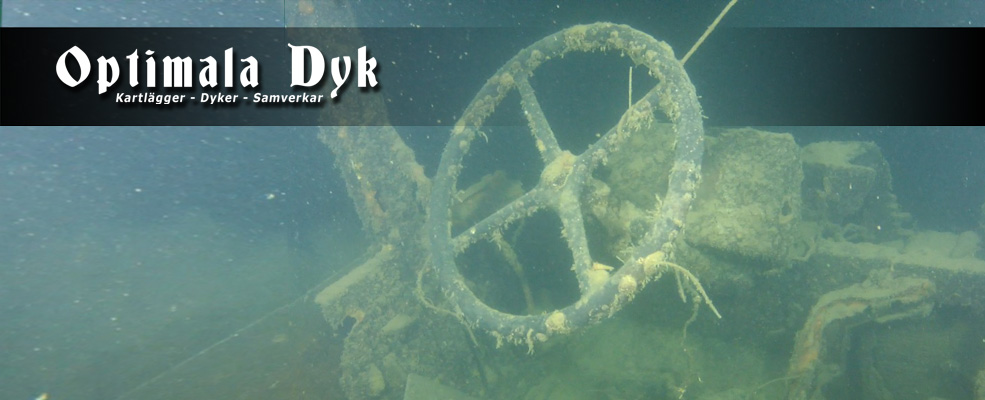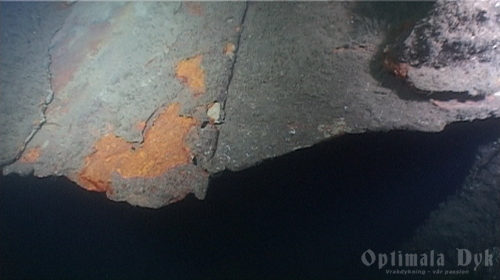
At the bottom of the Kattegat and Skagerrak many lost ships have found their last resting place. Over time, however, many of these wrecks are broken down. In the salty water iron is estimated to rust about 0.15 mm per year in the Kattegat, which means that wrecks from World War II have roughly 20 years left before they will collapse as the ships that went under in the first world war has already done to a great extent.
Many of the wrecks we dive on today were sunk during the Second World War. A big reason why so many ships were sunk in the Kattegat during World War II was because the Germans invaded Norway at an early stage in the war. Kattegat then served as a big shipping lane between Germany and occupied Norway.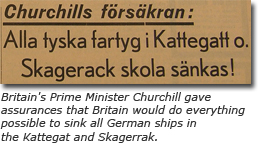
On April 9, 1940 Germans staged Operation Weserübung, the invasion of Denmark and Norway. The purpose of the operation was to gain control of ports along the coast of Norway, among other things to secure the war industry of important iron ore shipments from Kiruna which was shipped from Narvik and onwards down to Germany past Denmark and Sweden. Another reason for the invasion of Norway was that the Germans wanted to increase their area from where it was possible to attack Britain from and to guard the fairways towards Murmansk in Russia.
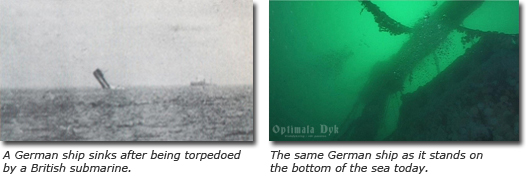 During the invasion, and also for the rest of the war, many ships sailed with troops, ammunitions, fuel and supplies through the Kattegat on their way to Norway. Along the routes towards Norway often British submarines were waiting to sink the German ships. Hence, many of these German ships now lie as wrecks on the seabed off the Swedish west coast.
During the invasion, and also for the rest of the war, many ships sailed with troops, ammunitions, fuel and supplies through the Kattegat on their way to Norway. Along the routes towards Norway often British submarines were waiting to sink the German ships. Hence, many of these German ships now lie as wrecks on the seabed off the Swedish west coast.
As the war went on the Allies made large four-engine bomber with greater range and greater bomb capacity than before to various cities in Germany. In 1942 the British bombings of Germany increased. And from the summer of 1943 and onwards the Allied superiority in the air increased, partly due to the Americans' help and partly because the Germans' relative reduction in the number of planes. The American bombers attacked during the day and during the nights the British carried out raids with their plans, which had greater loading capacity. The Germans had shortage of fuel which led to that during the latter part of World War II the German fighter planes had difficulty getting up in defense. In 1944 the Allied bombing campaign culminated with the bombing of Dresden, among others. Many Allied planes were shot down and many were injured hard and crashed into the Kattegat before they could reach back to their home bases in Britain.
In 1944 the allied bombers also performed anti-submarine missions in the Kattegat. The bombers flew out from the Hebrides and Scotland. The aim was to prevent the German ore shipme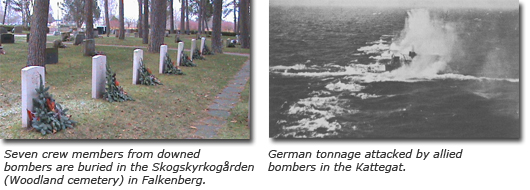 nts of Swedish iron ore that was transferred from Norway to Germany. The Allies also had so called "Strike Wings," which were units that specialized in shipping attacks during daytime. Radar was used to detect ships and aircraft were equipped with armor-piercing rockets and 20mm cannons to fight the German ships. The planes were based on Banff Airport in northeast Scotland where the name "Banff Strike Wing" is known. A Norwegian unit, who flew reconnaissance for the Allies, also flew out from Banff. All of Banff flew Mosquito planes and the operation area was determined to be between Oslo and Anholt and east of the 10th latitude.
nts of Swedish iron ore that was transferred from Norway to Germany. The Allies also had so called "Strike Wings," which were units that specialized in shipping attacks during daytime. Radar was used to detect ships and aircraft were equipped with armor-piercing rockets and 20mm cannons to fight the German ships. The planes were based on Banff Airport in northeast Scotland where the name "Banff Strike Wing" is known. A Norwegian unit, who flew reconnaissance for the Allies, also flew out from Banff. All of Banff flew Mosquito planes and the operation area was determined to be between Oslo and Anholt and east of the 10th latitude.
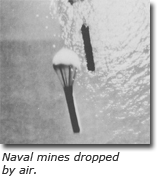 Often two planes from the Norwegian unit flew in front and scouted and reported back to the main force what they discovered, after which they attacked. During Octob
Often two planes from the Norwegian unit flew in front and scouted and reported back to the main force what they discovered, after which they attacked. During Octob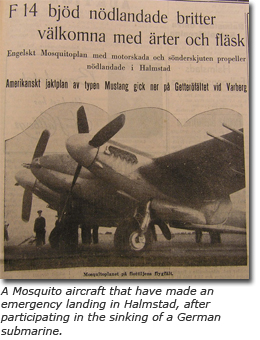 er and November 1944 the Allied conducted a total of 47 attacks against German ships in the Kattegat. During December the weather was very bad and they could not perform the same number of attacks.
er and November 1944 the Allied conducted a total of 47 attacks against German ships in the Kattegat. During December the weather was very bad and they could not perform the same number of attacks.
During the war the RAF (Royal Air Force) in total of 262 nights a lot of mine drops from the air in the Kattegat. Many ships sunk as a result of these mines.
In 1945 the British attacks on German tonnage intensified in the Kattegat as it was possible to put extra tanks of fuel in their aircraft and thus were able to get longer flight times than before. This enabled them to easily patrol across the Kattegat. In January and February the weather was bad, but in March was more than 80 attacks against German ships in the Kattegat. Up until the war ended in May continued these operations against German ships in the Kattegat. Many ships sunk in the final phase of the war.
Today many wrecks from the Second World War still lie on the seabed outside the Swedish West Coast. Despite this, there are few people who are aware of the tragedies and stories behind the shipwrecks. Our goal is to document as many wrecks as possible before they are gone so the history can be told.
